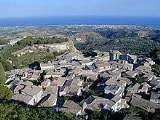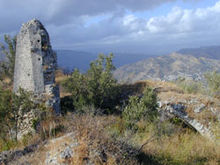
Gerace
Encyclopedia
Gerace is a town and comune
in the province of Reggio Calabria
, Calabria
, Italy
.
Gerace is located some 10 km inland from Locri
, yet the latter town and the Sea can be seen from Gerace's perch atop a 500 m vertical rock. The town stands on a hill formed of conglomerates of sea fossils from 60 millions years ago.
Ierax (Ιέραξ) ("Sparrowhawk"). According to a legend, the inhabitants of the coast, fleeing from a Saracen
attack in 915 CE, were led by a sparrowhawk to the mountains commanding the area of Locri, and here they founded the city. Archeological findings have showed that the area was in fact inhabited since the Neolithic Age; also traces of Sicel presence have been found.
Later, even during the highest splendour of Locri, the hill was inhabited and was later the site of a Roman military garrison. After the Byzantine
reconquest of Italy (6th century), the town became an administrative, military and religious capital under the name of Santa Ciriaca.
 In 986 the Saracens briefly conquered the city, but it returned to Byzantine
In 986 the Saracens briefly conquered the city, but it returned to Byzantine
control until the Norman
conquest in 1059. Gerace was seat of a principality under the Normans, whose symbol was the Castle of the Hautville or Altavilla
of the House of Candia
. It subsequently followed the history of the Kingdom of Naples
. During the Sicilian Vespers
(late 13th century), Gerace was occupied by the Aragonese Admiral Roger of Lauria
who turned it into his own feudal estate; later it became a "Royal City".
In 1348 it became a county, a possession of the Caracciolo
s, Gonzalo de Córdoba
and, as a principality, of the Grimaldi (end of the 16th century). With the abolition of feudalism in 1806, Gerace became district capital.
A new modern town, Gerace Marina, was built on the coast in the 19th century to house new public buildings. The name was changed to Locri in 1934.

Comune
In Italy, the comune is the basic administrative division, and may be properly approximated in casual speech by the English word township or municipality.-Importance and function:...
in the province of Reggio Calabria
Province of Reggio Calabria
The Province of Reggio Calabria is a province in the Calabria region of Italy. Its capital is the city of Reggio., it has an area of 3,183 km², and a total population of 565,866. There are 97 comuni in the province, see Comuni of the Province of Reggio Calabria.- Economy :The region is...
, Calabria
Calabria
Calabria , in antiquity known as Bruttium, is a region in southern Italy, south of Naples, located at the "toe" of the Italian Peninsula. The capital city of Calabria is Catanzaro....
, Italy
Italy
Italy , officially the Italian Republic languages]] under the European Charter for Regional or Minority Languages. In each of these, Italy's official name is as follows:;;;;;;;;), is a unitary parliamentary republic in South-Central Europe. To the north it borders France, Switzerland, Austria and...
.
Gerace is located some 10 km inland from Locri
Locri
Locri is a town and comune in the province of Reggio Calabria, Calabria, southern Italy. The name derives from the ancient Greek town Locris.-History:...
, yet the latter town and the Sea can be seen from Gerace's perch atop a 500 m vertical rock. The town stands on a hill formed of conglomerates of sea fossils from 60 millions years ago.
History
The name of the city derives from the GreekGreek language
Greek is an independent branch of the Indo-European family of languages. Native to the southern Balkans, it has the longest documented history of any Indo-European language, spanning 34 centuries of written records. Its writing system has been the Greek alphabet for the majority of its history;...
Ierax (Ιέραξ) ("Sparrowhawk"). According to a legend, the inhabitants of the coast, fleeing from a Saracen
Saracen
Saracen was a term used by the ancient Romans to refer to a people who lived in desert areas in and around the Roman province of Arabia, and who were distinguished from Arabs. In Europe during the Middle Ages the term was expanded to include Arabs, and then all who professed the religion of Islam...
attack in 915 CE, were led by a sparrowhawk to the mountains commanding the area of Locri, and here they founded the city. Archeological findings have showed that the area was in fact inhabited since the Neolithic Age; also traces of Sicel presence have been found.
Later, even during the highest splendour of Locri, the hill was inhabited and was later the site of a Roman military garrison. After the Byzantine
Byzantine Empire
The Byzantine Empire was the Eastern Roman Empire during the periods of Late Antiquity and the Middle Ages, centred on the capital of Constantinople. Known simply as the Roman Empire or Romania to its inhabitants and neighbours, the Empire was the direct continuation of the Ancient Roman State...
reconquest of Italy (6th century), the town became an administrative, military and religious capital under the name of Santa Ciriaca.

Catapanate of Italy
The Catepanate of Italy was a province of the Byzantine Empire, comprising mainland Italy south of a line drawn from Monte Gargano to the Gulf of Salerno. Amalfi and Naples, although north of that line, maintained allegiance to Constantinople through the catepan...
control until the Norman
Normans
The Normans were the people who gave their name to Normandy, a region in northern France. They were descended from Norse Viking conquerors of the territory and the native population of Frankish and Gallo-Roman stock...
conquest in 1059. Gerace was seat of a principality under the Normans, whose symbol was the Castle of the Hautville or Altavilla
Altavilla
Altavilla is a village and former municipality in the district of See in the canton of Fribourg, Switzerland.-History:It was first recorded in 1340 as Alta villa. It has also had the German name Altenfüllen and the French Hauteville....
of the House of Candia
House of Candia
The House of Candia is a European dynastic house, created by a junior branch of the House of Anjou originally from "Castrum Candiaco" in the Dauphiné of the nobility of Savoy and Piemont...
. It subsequently followed the history of the Kingdom of Naples
Kingdom of Naples
The Kingdom of Naples, comprising the southern part of the Italian peninsula, was the remainder of the old Kingdom of Sicily after secession of the island of Sicily as a result of the Sicilian Vespers rebellion of 1282. Known to contemporaries as the Kingdom of Sicily, it is dubbed Kingdom of...
. During the Sicilian Vespers
Sicilian Vespers
The Sicilian Vespers is the name given to the successful rebellion on the island of Sicily that broke out on the Easter of 1282 against the rule of the French/Angevin king Charles I, who had ruled the Kingdom of Sicily since 1266. Within six weeks three thousand French men and women were slain by...
(late 13th century), Gerace was occupied by the Aragonese Admiral Roger of Lauria
Roger of Lauria
Roger of Lauria, Loria or de Llúria in Catalan , was an Sicilian-Aragonese admiral, who was the commander of the fleet of Aragon during the War of the Sicilian Vespers. He was probably the most successful and talented naval tactician of the medieval period...
who turned it into his own feudal estate; later it became a "Royal City".
In 1348 it became a county, a possession of the Caracciolo
Caracciolo
Caracciolo is the surname of a famous noble family of southern Italy.Its members include:*Battistello Caracciolo, Italian painter*Carmine Nicolao Caracciolo, Spanish viceroy of Peru*Francesco Caracciolo, Neapolitan admiral and revolutionist...
s, Gonzalo de Córdoba
Gonzalo Fernández de Córdoba
Gonzalo Fernández de Córdoba known as The Great Captain, Duke of Terranova and Santangelo, Andria, Montalto and Sessa, also known as Gonzalo de Córdoba, Italian: Gonsalvo or Consalvo Ernandes di Cordova was a Spanish general fighting in the times of the Conquest of Granada and the Italian Wars...
and, as a principality, of the Grimaldi (end of the 16th century). With the abolition of feudalism in 1806, Gerace became district capital.
A new modern town, Gerace Marina, was built on the coast in the 19th century to house new public buildings. The name was changed to Locri in 1934.

Main sights
The main attractions of Gerace are the remains of the old Norman Castle (probably begun in the 10th century by the Byzantines) at the top of Gerace, and the perfectly preserved medieval town. It was once home to 128 churches; the most noteworthy amongst the remaining ones include:- Church of St. Francis (13th century), containing a precious Baroque altar.
- The NormanNorman architectureAbout|Romanesque architecture, primarily English|other buildings in Normandy|Architecture of Normandy.File:Durham Cathedral. Nave by James Valentine c.1890.jpg|thumb|200px|The nave of Durham Cathedral demonstrates the characteristic round arched style, though use of shallow pointed arches above the...
Cathedral, the largest religious building in Calabria, including the prison of the Five Martyrs of Gerace (1045). It has a nave and two aisles, each divided by 13 columns coming from the ancient temples of LocriLocriLocri is a town and comune in the province of Reggio Calabria, Calabria, southern Italy. The name derives from the ancient Greek town Locris.-History:...
. The cryptCryptIn architecture, a crypt is a stone chamber or vault beneath the floor of a burial vault possibly containing sarcophagi, coffins or relics....
is accessible also. It has also a museum, founded in 1996. - the small San Giovannello ("Little St. John", 10th century).
- Santa Maria del Mastro (1083), of Greek rite until 1480.

